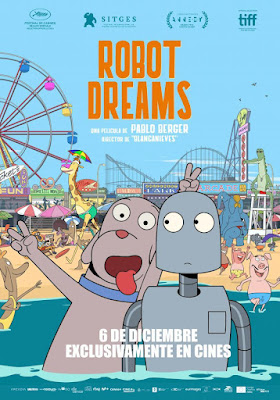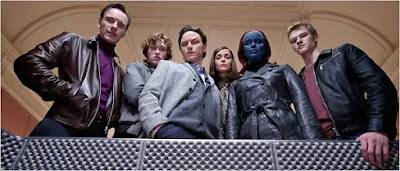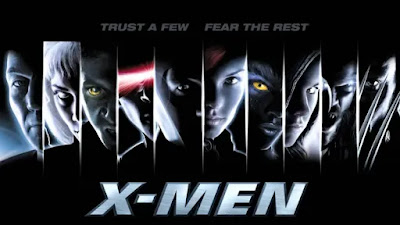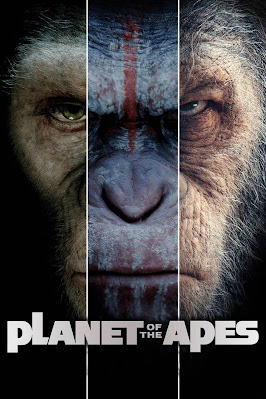WRITER’S NOTE: The following reviews were originally posted on my Instagram page @be.kerian in March and April of 2024. (For this post, the reviews for Dawn and War have been extended.)
[POSTSCRIPT: My review for Kingdom was added on May 13, 2024.]
At the turn of the century, Hollywood attempted to remake several classic films for a new generation. This 2001 revamp from director Tim Burton (based off the 1968 sci-fi saga starring Charlton Heston) was one of them. In this version, Mark Wahlberg plays an Air Force pilot on a space station that uses chimpanzees as test subjects for interstellar travel. When one of them gets lost, Wahlberg’s Leo Davidson goes on a mission to bring him back but gets caught in a wormhole that sends him to a strange planet where talking apes rule and humans are enslaved.
Honestly, the one great thing this
Planet of the Apes had going for it was
Rick Baker’s incredible makeup effects. As it turns out, this would be the last time that makeup artists would work on an
Apes feature. For Baker, it was a dream come true. And it shows, especially with such committed actors as Michael Clarke Duncan (as a brute soldier) and Cary-Hiroyuki Tagawa (as a doubtful gorilla). Tim Roth (as a snarling general) and Paul Giamati (as a wacky orangutan), on the other hand, ham it up too much.
While this flick has spectacle and action to spare (and a few homages to the original), it lacks the intellect that made that flick such a thrilling adventure. The visual effects, technology, and millennial vibes in this reimagining haven’t aged well, while other elements are just weird and suggestive. More importantly, the story is convoluted, forgettable, and lacks a genuine sense of mystery, including the origins of the titular planet. Even its own twist ending is confusing rather than shocking—an element that ruins the rest of the movie, and is likely one reason it performed below expectations and killed a potential new franchise.
Filmmaker James Cameron once claimed that this remake didn’t work because the studio hired the wrong director. Agreeably, Apes isn’t really Burton’s kind of movie. (Even he admitted it wasn’t a great experience, as the studio reportedly set a release date before a script was even finished.) At least his next film (Big Fish) was more up his alley, while it would be another ten years before Planet of the Apes found a better one.
Ten years after an unsuccessful reboot, Fox decided to give the Planet of the Apes series another try. Only this time, instead of using practical makeup effects, the filmmakers of Rise of the Planet of the Apes turned to the same motion-capture technology and visual effects company (Weta Digital) that brought the Na’vi of James Cameron’s Avatar to life. And for the Apes lead character, Caesar, they turned to actor Andy Serkis (the same man who breathed life into Gollum and King Kong). The result is a thoroughly convincing and evocative performance.
Like the 1968 original, Rise doesn’t just rely on its technical achievements. (This was also the first movie to shoot mo-cap in outdoor environments.) It succeeds as a smart and thrilling present day sci-fi drama—in which a group of scientists (headed by James Franco’s sympathetic-if-misguided Will Rodman) create an experimental drug as a potential cure for Alzheimer’s disease. When a chimpanzee test subject tragically dies, the serum transfers to her offspring (Caesar), whom Will decides to raise. Caesar’s intellectual growth eventually persuades Will to try the drug on his ailing father (a compelling John Lithgow), a further key example of the story’s central-if-cliched notion of “playing God,” especially when the consequences eventually rear their ugly head.
But when Caesar is discovered and feared in public, he is forced into an animal shelter. Considered by many as a loose remake of 1972’s Conquest sequel, Caesar plans an escape and revolution for him and the other captive simians. (Audiences should know that this gripping and jaw-dropping film is also, according to the MPAA, “intense and frightening.”)
As for the film’s human cast (including David Oyelowo’s business CEO and Tom Felton’s animal control employee), some of them come across as one-dimensional. The story also rushes a bit, but really works when it’s just apes communicating through body or sign language, or when they’re in nature. It’s really something to see and hear. A film that apparently nobody asked for but far exceeded expectations, Rise is the best reboot since Batman Begins.
The second installment in the rebooted
Planet of the Apes series has something in common with
Mad Max 2: The Road Warrior: both predecessors took place in the present-day, while the sequels represented more of the post-apocalyptic worlds they’re generally known for. In
Dawn of the Planet of the Apes, a virus that resulted from an experimental drug gone wrong has wiped out much of the human population around the globe. The few “genetically-immune” survivors try to make do with the resources they have, and to make contact with the outside world. Meanwhile, a colony of intelligent apes (led by Caesar) roams the forests on the outskirts of what remains of San Francisco—and Western civilization.
The latter group is what makes the more elemental and universal Dawn feel like a silent picture half the time, as these simians communicate through sign and body language, and a limited vocabulary. Caesar is much more reserved and snarling this time around, wanting to protect his family and community. In fact, several other characters (like Jason Clarke’s Malcolm and Gary Oldman’s Dreyfus), who illustrate strong parent-child relationships, want a better life, and hope to reconnect, rebuild, and share resources with others. And while Caesar wants nothing to do with humanity at first, he comes to see the morally gray areas of both man and beast. It’s a testament to the dedication of actor Andy Serkis, as we really feel what Caesar is thinking, even if we don’t know what it is exactly.
This is a rare sequel that really improves on its predecessor in every way, thanks, in part, to phenomenal direction by Matt Reeves, incredible production design by James Chinlund, and brilliant writing by Rick Jaffa, Amanda Silver, and Mark Bomback. It ranks as another milestone in motion capture performance (courtesy Weta Digital), this time shot in raining environments and in a taller aspect ratio.
That being said, Dawn is also a much more violent entry (competing with 1972’s Conquest), with scenes of gunplay, language issues, and a few startling moments. Part of that has to do with characters’ conflicting motivations and agendas. Characters who are unwilling to let go of deep-seated anger and hatred, resulting in betrayal and broken trust.
The chief example is the bonobo ape Koba (Toby Kebbell), an abused test subject (from Rise) who serves as this film’s main antagonist. Like Aldo in 1973’s Battle, he’s a character who is willing to kill even his own kind to get what he wants, adding to this narrative’s themes of fear and destruction against peace and understanding. And although Michael Giacchino’s score does have some clever homages to Jerry Goldsmith’s music from the original movies (scenes in underground tunnels recall 1970’s Beneath), Dawn is a more gripping and exhilarating slow-burn of a drama.
As its title suggests, this third installment in the Planet of the Apes reboot series is a war picture. But it’s so much more than that. Set two years after the events of Dawn, military soldiers answer a distress call to search for and eradicate the ape colony led by the now-legendary Caesar. While the rest of his community relocates in search of a safer haven (an Exodus, if you will), Caesar goes on a personal mission to find the merciless Colonel (played by a chilling Woody Harrelson, channeling Kurtz from Apocalypse Now) who murdered Caesar’s family sans his youngest child.
Accompanied by three companions, including fellow chimp Rocket (series regular Terry Notary) and the wise orangutan Maurice (Karin Konoval, who’s been a standout since Rise), the journey is both epic and intimate. It’s Sergio Leone-meets-David Lean, from the shores of a beach to the frozen hideout of a former zoo animal named “Bad Ape” (played with comic relief by the naturally-funny Steve Zahn), and the central “Alpha Omega” military base that cages and enslaves other apes. Meanwhile, the virus that wiped out half of humanity (between Rise and Dawn) has apparently mutated, leaving its victims literally speechless, including a little girl that Maurice eventually names “Nova” (played wonderfully by newcomer Amiah Miller).
But War is not just a physical conflict between men and simians. It’s also a soulful and moral struggle for Caesar, as he is haunted by memories of his deceased friend-turned-enemy Koba (the antagonist of Dawn) and risks losing his own humanity and compassion. This easily tops its predecessor as the most violent Apes chapter, with numerous battle sequences and brutal winter conditions that test our characters physically and psychologically. It’s also the most melancholy, emotional, and spiritual entry, with deeply biblical and mythological parallels (some profound; others, quietly empowering), thanks, in part, to Michael Giacchino’s moving score (especially Nova’s theme) and a thoroughly gripping, subversive, and literally explosive tone.
The motion capture technology has become so seamless by this point—as great as it’s ever been, actually—that it blurs the line between science-fiction and reality at times, even in groundbreaking snow conditions. Director/writer Matt Reeves and co-writer Mark Bomback have done an equally great job of interweaving themes and definitions of “mercy,” “nature,” “sacrifice,” and “salvation,” as well as themes of identity and character.
On the other hand, it is ironic that the narrative has us rooting for the apes more than the human characters, most of which are unsympathetic here, or die from bloody illnesses. (Nova may be the lone exception.) As Bad Ape describes, “Human get sick while ape get smart”—a potential prelude, as well as thematic full-circle connection, to the 1968 original. What a way to cap a trilogy for the time being.
Passing the torch of a film franchise from one director to the next is always a daunting task, especially if there’s a generational gap. What’s interesting about the original Planet of the Apes movies is they were products of their time (the late-1960s and early-1970s were a period of Vietnam, Watergate, and civil rights marches).
The rebooted trilogy from the past decade has allowed filmmakers and artists to successfully update author Pierre Boulle’s original concept, by transitioning from practical effects to digital performances, all while keeping the storylines engrossing and thoughtful. In retrospect, 2011’s Rise, 2014’s Dawn, and 2017’s War, strangely foreshadowed where the world would be in the not-too-distant future. (Since 2020, we’ve had to deal with a global pandemic for real.) So the themes in this larger narrative remain as (if not more) relevant than ever.
With Kingdom of the Planet of the Apes, director Wes Ball (The Maze Runner) picks up where Rupert Wyatt and Matt Reeves left off. Set 300 years after the events of War, a young chimpanzee named Noa (an engrossing Owen Teague) has much growth and knowledge to gain in his community. But when his village is attacked and taken captive by a power-hungry simian army, he goes on a quest to find his tribe and bring them back from a sadistic bonobo leader named Proximus (a commanding and chilling Kevin Durand). Along the way, he meets a wise orangutan named Raka (a wonderful Peter Macon) and a mysterious human girl named Mae (an incredible Freya Allan) with more to her than meets the eye.
The world-building of this new iteration is captivating and awe-inspiring, from the sights of algae-covered skyscrapers in ruins, to motifs of waterfalls, eagles, and telescopes and satellites (symbols of hope and communication) looking to the sky. It’s a seamless balance of visual effects (courtesy Weta) and real locations. Proximus’s “wonderful day” catchphrase even gives this series another thing in common with Mad Max.
The story of Kingdom takes on mythological and even Biblical proportions. Specifically, the idea of stories and legends from one generation that have either been forgotten or not passed on to the next. This is exemplified in two different clans of apes going toe-to-toe, physically and with conflicting worldviews and ideologies about community, laws, and how they treat or view human beings. Ditto themes of meaning, understanding, truth, trust, and honoring or dishonoring who we are and where we came from. It also begs the question (as cliché as it is): is it possible for two different species to co-exist and rebuild in a broken world?
While Kingdom doesn’t quite reach the rock-climbing heights of Reeves’ previous installments, Ball’s take manages to be both a clever homage and a jaw-dropping, subversive narrative. Some throwbacks to the 1968 original are a bit much, but Kingdom represents a full-circle event that carries on the series in some unexpected and challenging directions, regarding the roles of humanity and stewardship (or the lack of both), as well as issues of submission, conformity, and ownership. It’ll be something to see where this franchise heads next.









